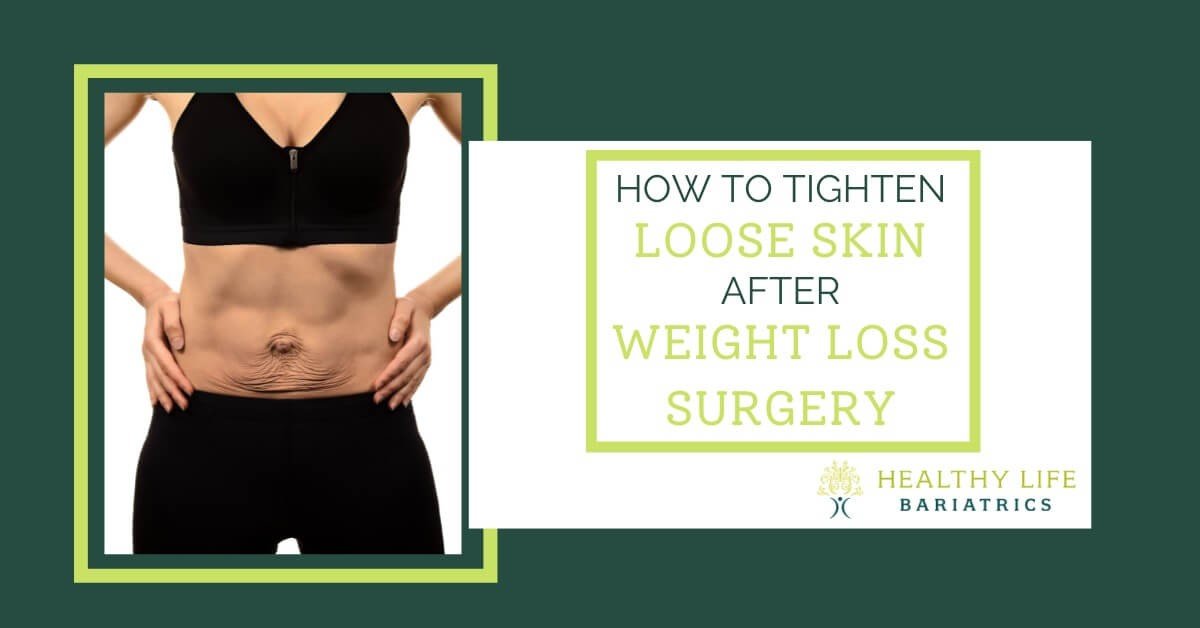
One worry people have about weight loss surgery is that they will be left with saggy skin that hangs. Hanging skin is not guaranteed in all weight loss surgery patients, but the problem can occur.
Here’s how it happens.
When you gain weight, your skin expands to accommodate your larger body. Following weight loss surgery, the excess weight comes off quickly. For instance, it’s common for patients to see losses of 100 pounds or more in the first two years. With such rapid weight loss, your skin typically doesn’t have enough elasticity to shrink back down, resulting in loose and sagging skin.
There are a few treatments for loose skin. Before we get to those, let’s examine how loose skin can affect your quality of life.
How Does Loose Skin Affect You?
The amount of excess skin you experience depends on your weight before surgery, age, genetics, and lifestyle habits such as smoking. For many, the loose skin becomes a mere aesthetic problem. For others, the hanging skin can pose real problems. Here are some of the issues you could experience due to your hanging skin following weight loss surgery.
- Chafing: As you go about your day, the excess skin could rub together, leading to painful irritation.
- Rashes: The skin may rub against other folds of skin where the area remains moist, leading to persistent skin discomfort and redness.
- Skin tears: The saggy skin can rub together so much that the upper layer of the epidermis begins to tear.
- Infections: Loose skin folds are difficult to clean, leading to the potential for serious and deadly infections.
- Embarrassment: Even small amounts of excess skin can affect how you feel about your body.
Because most people will experience at least some amount of extra skin after significant weight loss, the following treatments can help solve the problem.
Excess Skin Removal Treatments

There are several ways you can minimize excess skin after weight loss surgery. The first three involve non-surgical means.
Balanced Diet
Your weight loss surgeon can help you alter your lifestyle post-surgery to maximize your weight loss potential. You may, for example, receive helpful hints about keeping your diet in check. Follow your surgeon’s advice by consuming a balanced diet with plenty of protein and vitamins.
Eating the recommended servings of protein each day can make it easier to keep the weight off post-surgery. At the same time, protein helps you build lean muscle, which in turn causes you to burn more calories at rest. Getting enough protein has a bonus effect of helping to improve skin elasticity. Aim to eat around 60 to 80 grams of protein per day.
Skin elasticity can also be improved by consuming foods high in vitamins C, E, A, K, and B, as well as trace minerals like zinc. Be sure to drink your fill of water as well. To stay hydrated throughout the day, try to drink at least 64 to 96 ounces of water per day.
By following this diet, you’ll look better, feel better, and hopefully minimize loose skin.
Fitness Routine
Getting into the habit of moving your body is excellent for weight loss and loose skin management after weight loss surgery. Exercising (and eating protein) helps to build lean muscle mass. The more muscle mass you manage to grow, the less saggy skin you’ll have.
Work with your bariatric surgeon to adopt an exercise routine that helps you lose weight and feel great while minimizing your excess skin.
Skin Care Regimen
Here’s a riddle for you. What is the human body’s largest organ? If you answered skin, you’re correct! The skin is an organ just like your kidneys and heart. To avoid seeing loose skin following weight loss surgery, taking care of this major organ can do wonders.
Try this trick to increase circulation in your skin. Doing so can help to carry collagen and elastin throughout each layer, which can help with sagging skin. You can improve your blood flow beneath the skin’s surface by using a soft-bristled brush. Brush your skin lightly all over or get a loved one to help. You may just find your skin shrinking to accommodate your new thinner body.
Cosmetic Surgery

The above actions – eating a healthy diet, exercise, and improving circulation – are designed to assist with minor cases of loose skin. For more significant cases where the hanging skin causes chafing, rashes, and other problems, cosmetic surgery may be your best available solution.
Cosmetic surgery following weight loss surgery is known as post-bariatric body contouring. Weight loss surgery patients often turn to body contouring to improve their appearance and self-esteem. In fact, a study published in the National Library of Medicine found that 74% of bariatric patients desired post-bariatric body contouring after losing weight. If you have hanging skin and want it gone, you’ll be in good company by choosing post-bariatric body contouring. There are several procedures you can choose from.
Tummy Tuck (Abdominoplasty)
After weight loss surgery, a tummy tuck can remove excess skin to improve your appearance. In some cases, the tummy tuck can alleviate back pain and incontinence.
During a tummy tuck, your cosmetic surgeon removes excess skin while tightening your abdominal muscles. After surgery, exercise makes it easier to build abdominal muscles on your own.
A tummy tuck is typically not covered by insurance. It is an elective cosmetic procedure with an average cost of $6,092 and two to four hours.
Belt Lipectomy
A belt lipectomy is useful for eliminating major amounts of hanging skin on the lower abdomen following a weight loss surgery procedure.
During the body contouring surgery, your surgeon will make two incisions into the abdominal wall. The excess skin will be removed before the bottom portion of the skin is reattached to the top via suturing.
A belt lipectomy surgery could be considered medically necessary if the excess skin negatively affects your quality of life and thus may be covered by insurance. The out-of-pocket cost can range from $15,000 to $20,000, not including anesthesia and other fees. The surgery takes between two and five hours to complete.
Lower Body Lift
The belt lipectomy is often used as part of a lower body lift, a series of procedures to address sagging skin on the lower body. The body parts in this subgroup include the lower abdomen, thighs, buttocks, flanks, and hips.
For the lower abdomen, your cosmetic surgeon may opt for the tummy tuck or belt lipectomy.
Your surgeon may then employ an upper thigh lift and butt lift to remove excess fat and tighten loose skin on other lower body areas. These techniques are designed to give your body a streamlined look.
Each of these procedures involves cutting away excess skin and removing fat using liposuction.
After surgery, your lower body will have a sleek and better-contoured silhouette.
The average cost of a lower body lift is $8,073, not including anesthesia and other surgical fees, and may be completed in one or more surgical sessions.
Upper Body Lift

An upper body lift consists of several surgeries designed to tighten and rejuvenate various body parts on the upper body. There is the upper arm lift (or arm reduction), breast lift (and breast augmentation), and back lift (also referred to as a bra-line lift).
An upper arm lift (brachioplasty) involves the removal of excess skin and liposuction to remove excess fat. The treatment area extends from the elbow to the armpit, making the upper arm look tighter and more youthful.
For the breast lift, your cosmetic surgeon will make three incisions. The first will go around the areola, the second will extend from the bottom of the areola down to the breast crease, and the third will go underneath the breast, following its natural curve.
After removing excess skin, your surgeon will relocate your nipples and areolas to match the higher position of your breasts on the chest. Men may instead opt for male breast reduction surgery or gynecomastia surgery as part of the upper body lift procedure.
Bra lift surgery goes from one side of the chest to the other and extends around the upper back. After surgery, you’ll have much tighter skin on the upper back area.
During an upper body lift, your surgeon will remove the excess skin before using liposuction to extract excess fat. The post-bariatric body contouring surgery leaves a scar that usually runs along the bra line.
Lower and upper body lifts, which have an average cost of $7,700, are considered cosmetic and thus are not typically covered by insurance. However, medical financing through companies like CareCredit and Prosper Healthcare Lending is available to offset the burden.
Hanging Skin Doesn’t Have to Be a Problem!
Post-bariatric body contouring has made many advancements in recent years. Because extreme weight loss can cause the skin to sag, many weight loss surgery patients seek body contouring to achieve their body shape goals. And the results are astounding.
By incorporating a tummy tuck lower or upper body lift into your post-bariatric treatment plan, your skin will be able to match your new slimmer body. To ensure the best results, seek out a cosmetic surgeon who is trained and experienced to perform body contouring after weight loss surgery.
If you live in the greater Los Angeles area, contact Moein Surgical Arts. Dr. Babak Moein is one of the few surgeons in the country trained in bariatric surgery and post-bariatric body contouring. That means you get all your services under one roof – weight loss surgery to drop the excess pounds and body contouring to achieve your aesthetic ideal. Learn more by calling to schedule a consultation and ask about eliminating loose skin after weight loss surgery (310)861-7844.
